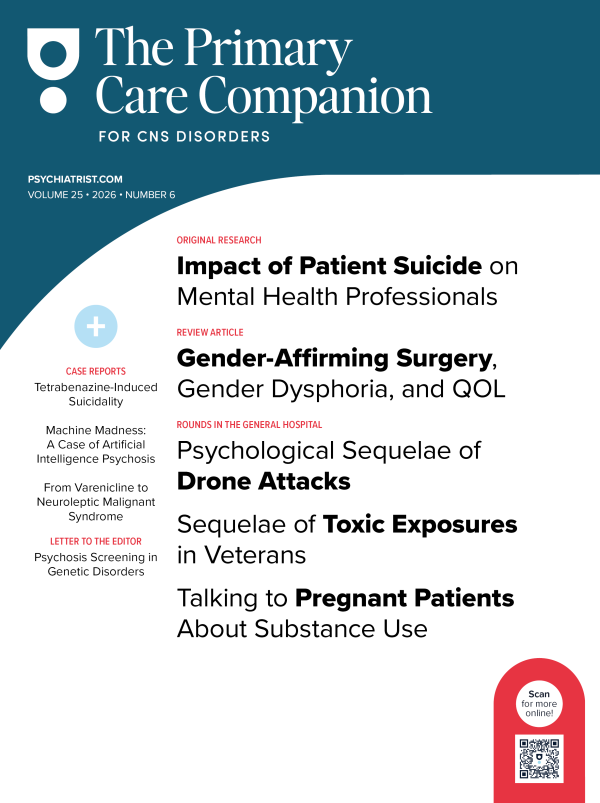Because this piece does not have an abstract, we have provided for your benefit the first 3 sentences of the full text.
To the Editor: Paroxetine is a selective serotonin reuptake inhibitor (SSRI) that is approved by the US Food and Drug Administration (FDA) for adult depression, obsessive-compulsive disorder, anxiety disorders, and vasomotor changes of menopause. Nonetheless, its clinical use has recently fallen into disfavor. Moreover, the FDA advised against its use in the child and adolescent population.
Paroxetine: Into Oblivion?
To the Editor: Paroxetine is a selective serotonin reuptake inhibitor (SSRI) that is approved by the US Food and Drug Administration (FDA) for adult depression, obsessive-compulsive disorder, anxiety disorders, and vasomotor changes of menopause. Nonetheless, its clinical use has recently fallen into disfavor.1 Moreover, the FDA advised against its use in the child and adolescent population.
This aversive attitude in practice might be ascribed to a multitude of reasons related to its pharmacologic properties. These properties might be broadly subdivided into anticholinergic actions, cytochrome P450 2D6 (CYP2D6) inhibitory properties, and a miscellaneous group.
Anticholinergic actions. Paroxetine is the most anticholinergic of the SSRIs on the market, which is especially problematic in the geriatric population due to its anticognitive properties. Paroxetine has been associated with highest weight gain among the SSRIs,2 mainly during the first 12 months of treatment. Antimuscarinic and sedative properties of paroxetine might be contributory to weight gain. Also, paroxetine is infamous for sexual dysfunction (up to 75% of patients), and it is more likely to cause disorders of arousal and anorgasmia than other SSRIs.
CYP2D6 inhibitory properties. Paroxetine is a potent CYP2D6 inhibitor, so pharmacokinetic interactions with drugs that are substrate to CYP2D6 are commonplace (eg, risperidone). This pharmacological portfolio, especially in poor metabolizers, may translate into clinical toxicity. Furthermore, inhibiting CYP2D6 may render drugs like tamoxifen in breast cancer ineffective by blocking its conversion into endoxifen.
Paroxetine is notorious for its discontinuation syndrome, which may, in part, be due to its ability to inhibit its own metabolism3—as it is a substrate for CYP2D6—hence, the rapid decline of levels and discontinuation symptoms once it is rapidly stopped.
Miscellaneous. Paroxetine has been tied to activation of suicidal ideations most often in youth. The FDA downgraded paroxetine to pregnancy category D, as association with ventricular septal defects has been reported. Notably, in the child and adolescent population, 2 randomized controlled trials4,5 of paroxetine for juvenile depression were negative. Last, but not least, paroxetine has been demonstrated to decrease the heart rate variability, which has been linked to increased cardiovascular mortality.6
Conclusion. In all, I surmise that the problems and inherent risks associated with paroxetine use speak to the idea of a psychotropic "falling off the track" and render it a less appealing choice in clinical practice compared to far more efficacious and safer alternatives already available on market. It is then incumbent on clinicians to be vigilant and prudent when prescribing paroxetine, especially in child and adolescent, female, and geriatric populations.
References
1. Nevels RM, Gontkovsky ST, Williams BE. Paroxetine: the antidepressant from hell? probably not, but caution required. Psychopharmacol Bull. 2016;46(1):77-104. PubMed
2. Fava M, Judge R, Hoog SL, et al. Fluoxetine versus sertraline and paroxetine in major depressive disorder: changes in weight with long-term treatment. J Clin Psychiatry. 2000;61(11):863-867. PubMed CrossRef
3. DeVane CL. Pharmacokinetics, drug interactions, and tolerability of paroxetine and paroxetine CR. Psychopharmacol Bull. 2003;37(suppl 1):29-41. PubMed
4. Emslie GJ, Wagner KD, Kutcher S, et al. Paroxetine treatment in children and adolescents with major depressive disorder: a randomized, multicenter, double-blind, placebo-controlled trial. J Am Acad Child Adolesc Psychiatry. 2006;45(6):709-719. PubMed CrossRef
5. Berard R, Fong R, Carpenter DJ, et al. An international, multi-centre, placebo-controlled trial of paroxetine in adolescents with major depressive disorder. J Child Adolesc Psychopharmacol. 2006;16(1-2):59-75. PubMed CrossRef
6. Yeh TC, Kao LC, Tzeng NS, et al. Heart rate variability in major depressive disorder and after antidepressant treatment with agomelatine and paroxetine: findings from the Taiwan Study of Depression and Anxiety (TAISDA). Prog Neuropsychopharmacol Biol Psychiatry. 2016;64:60-67. PubMed CrossRef
aChild/Adolescent Psychiatry, Kuwait Center for Mental Health, Kuwait
Potential conflicts of interest: None.
Funding/support: None.
Published online: January 11, 2018.
Prim Care Companion CNS Disord 2018;20(1):17l02113
To cite: Naguy A. Paroxetine: into oblivion? Prim Care Companion CNS Disord. 2018;20(1):17l02113.
To share: https://doi.org/10.4088/PCC.17l02113
© Copyright 2018 Physicians Postgraduate Press, Inc.
Please sign in or purchase this PDF for $40.00.





